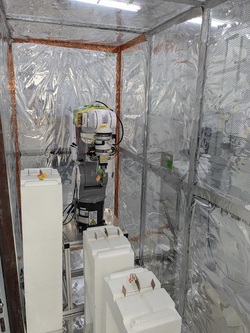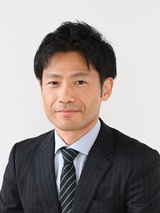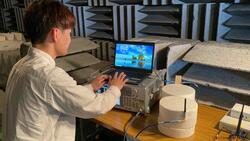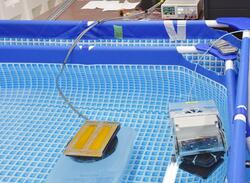
Tamura, Masaya
| Affiliation | Department of Electrical and Electronic Information Engineering |
|---|---|
| Title | Professor |
| Fields of Research | High frequency circuits / Wireless power transfer / Microwave circuits |
| Degree | Doctor of Informatics (Kyoto Univ.) |
| Academic Societies | IEEE / IEICE |
| tamura@ee Please append ".tut.ac.jp" to the end of the address above. |
|
| Laboratory website URL | http://www.comm.ee.tut.ac.jp/em/index.html |
| Researcher information URL(researchmap) | Researcher information |
Research
Our daily lives are surrounded by electromagnetic wave. It includes not only radio wave utilized in the data transmission but also heat radiation from our body and sunlight. We are widely conducting basic & applied researches with the aim of social contribution using the electromagnetic field; Basic researches are wireless power transfer under water and development of the resonator with high quality factor used in RF filter. Applied research is realization of the two-way communication module that can work by wireless power transfer.
Theme1:Smart Factory
Overview
 Experiment on wireless power transmission to multiple receivers placed in a model house simulating a factory
Experiment on wireless power transmission to multiple receivers placed in a model house simulating a factoryNumerous sensors are installed in various facilities and equipment for the purpose to support safe and secure life. In particular, power supply by wireless power transfer is expected for the sensors in dangerous places such as infrastructures in factory and power plant. We are developing a unique system with the pseudo-shielded space, which makes it possible to confine the electromagnetic field in the space and communicate with the sensors outside the space.
Selected publications and works
[1] Y. Tamura, H. Saeki, M. Tamura, “System Design of Cavity Resonance-enabled Wireless Power Transfer Based on Filter Design Theory,” IEEE ACCESS, vol. 12, pp.43341-43349, Mar. 2024.
[2] S. Akai, H. Saeki, M. Tamura, “Power Supply to Multiple Sensors and Leakage Field Analysis Using Cavity Resonance-Enabled Wireless Power Transfer,” in Proc. 2022 IEEE MTT-S Int. Microwave Symposium, Denver, CO, Jun. 2022, pp.271-274.
[3] S. Nimura, D. Furusu, M. Tamura,“ Improvement in Power Transmission Efficiency for Cavity Resonance-Enabled Wireless Power Transfer by Utilizing Probes With Variable Reactance,” IEEE Trans. Microwave Theory and Techniques, vol. 68, no. 7, pp.2734-2744, Jul. 2020.
[4] D. Furusu, M. Tamura,“Design of Capacitive Planar Power Transmitter and Receiver for Cavity Resonance enabled Wireless Power Transfer,” IEEE Microwave and Wireless Components Letters, vol. 29, no. 8, pp.566-568, Aug. 2019.
Keywords
Theme2:Next-Generation Wireless RF Circuits
Overview
Various methods in order to achieve high-speed and large-capacity wireless communications are developed such as Massive-MIMO, In-band full-duplex, and OAM. We aim to develop the RF circuits that are key technologies to realize these methods. As we image the application to a wide target range from portable devices to base station in small cell, we are developing value-added solutions such as high tunability and high power capability corresponding to the targets.
Selected publications and works
[1] K. Matsumoto, M. Hasan, H. Saeki, K. Katsumura, M. Tamura, “Design of a Decoupling Network Utilizing Antennas as Resonators,” IEICE Trans. Electronics, vol. E109-C, no. 10, pp.1-9, Oct. 2025. (Advance publication)
[2] T. Z. Earn, K. Matsumoto, M. Takagi, H. Saeki, M. Tamura, “Design Procedures of Decoupling Circuit Utilizing Coupling Between Antennas,” IEICE Trans. Electronics, vol. E108-C, no. 3, pp.127-138, Mar. 2025.
[3] K. Yoshihara, M. Tamura, Y. Miyaji, A. Alphones, “Dual Band SIW Cavity-Backed Crossed-Slot Antenna,” in Proc. 2019 Asia-Pacific Microwave Conference, Singapore, Dec. 2019, pp.1775-1778.
[4] K. Satoh, M. Tamura, “Filter using cylindrical quadruple mode SIW resonator,” IEICE Electronics Express, ELEX, vol.15, No.9, pp.1-6, #20180295, Apr. 2018.
Keywords
Theme3:Wireless Power Transfer under Water
Overview
Autonomous underwater vehicles are desired to charge battery and communicate information under water in order to improve operation efficiency. We have an ambitious goal of developing the wireless power and data transfer system for operation underwater, focusing on the capacitive coupling with a simple structure and low leakage of field. We are also developing the application of this technology to wireless power supply for bio-implantable medical devices.
Selected publications and works
Wireless power charging for implantable medical devices:
[1] K. Makabe, R. Aoyama, Y. Naka, M. Tamura, “Power Receiving Circuit Design of Single-ended Biological Capacitive WPT for Artificial Retina System,” in Proc. 2025 IEEE MTT-S Int. Microwave Symposium, San Francisco, CA, Jun. 2025, pp.81-84.
[2] T. Segawa, R.i Aoyama, M. Tamura, “Electrode Design Theory Using Highly Accurate Equivalent Circuits in Biological Capacitive WPT,” IEEE Microw. Wirel. Techn. Lett., vol. 33, no. 6, pp.943-946, Jun. 2023.
[3] M. Matsumoto, M. Tamura, “Coupler Design and Analysis of Capacitive Wireless Power Charging for Implantable Medical Devices,” IEICE Trans. Electron., vol. E105-C, no. 9, pp.398-406, Sep. 2022.
[4] M. Tamura, T. Segawa, M. Matsumoto,“Capacitive Coupler for Wireless Power Transfer to Intravascular Implant Devices,” IEEE Microw. Wirel. Compon. Lett., vol. 32, no. 6, pp.672-675, Jun. 2022.
Underwater wireless power transfer:
[1] Y. Naka, A. Ishiwata, M. Tamura, “Capacitive Wireless Power Transfer System with Misalignment Tolerance in Flowing Freshwater Environments,” IEICE Trans. Electronics, vol. E107-C, no. 2, pp.47-56, Feb. 2024.
[2] Y. Naka, M. Tamura, “Design of a Capacitive Coupler for Underwater Wireless Power Transfer Focused on the Landing Direction of a Drone,” IEICE Trans. Electronics, vol. E107-C, no. 3, pp.66-75, Mar. 2024.
[3] M. Tamura, K. Murai, M. Matsumoto, “Design of Conductive Coupler for Underwater Wireless Power and Data Transfer,” IEEE Trans. Microwave Theory and Techniques, vol. 69, no. 1, pp.1161-1175, Jan. 2021.
[4] M. Tamura, Y. Naka, K. Murai, T. Nakata, “Design of a Capacitive Wireless Power Transfer System for Operation in Fresh Water,” IEEE Trans. Microwave Theory and Techniques, vol. 66, no. 12, pp.5873-5884, Dec. 2018.
Keywords
Title of class
Electric Circuit 1 / RF Circuit Engineering / Microwave Circuits / Advanced Communication Systems 2



